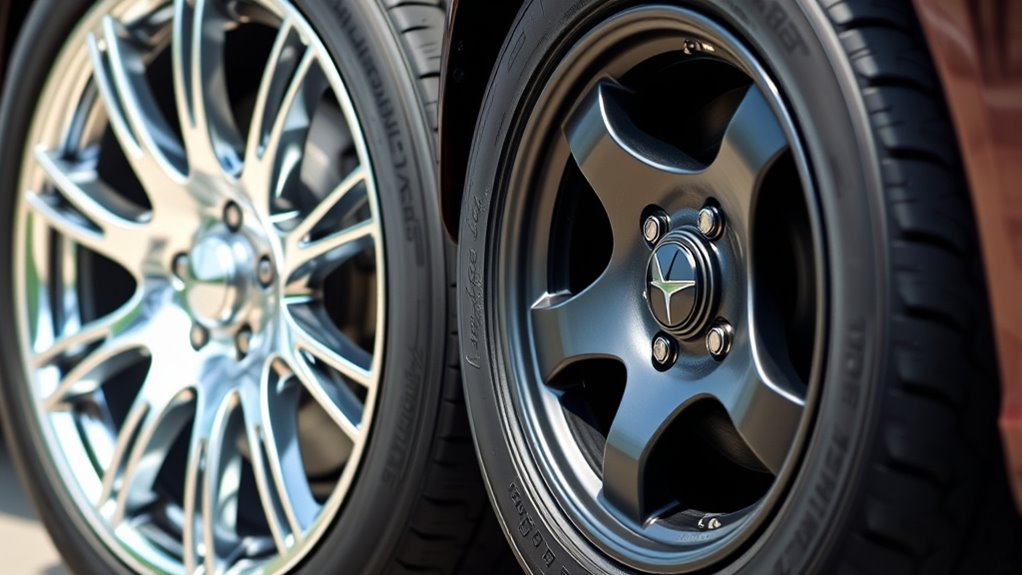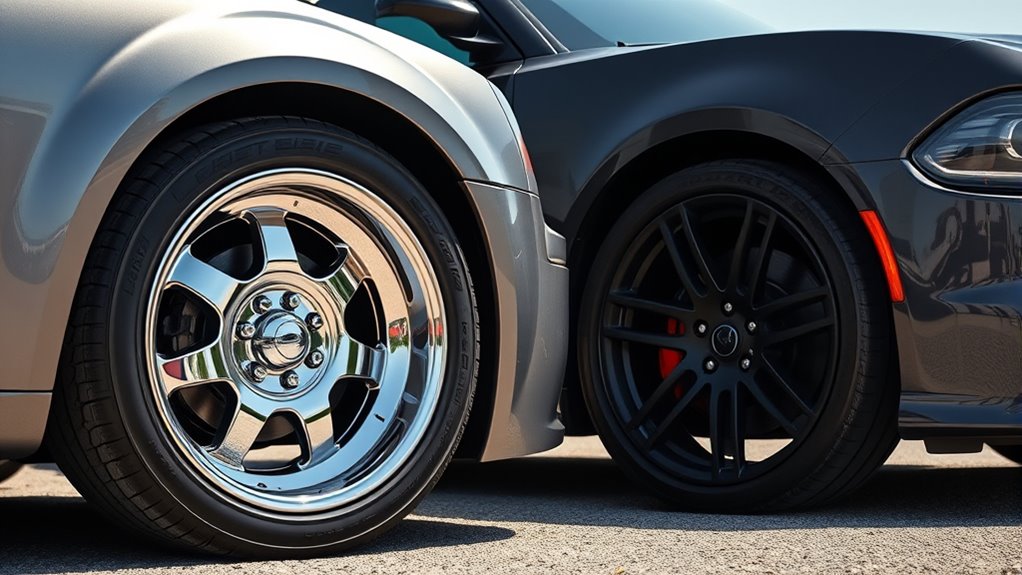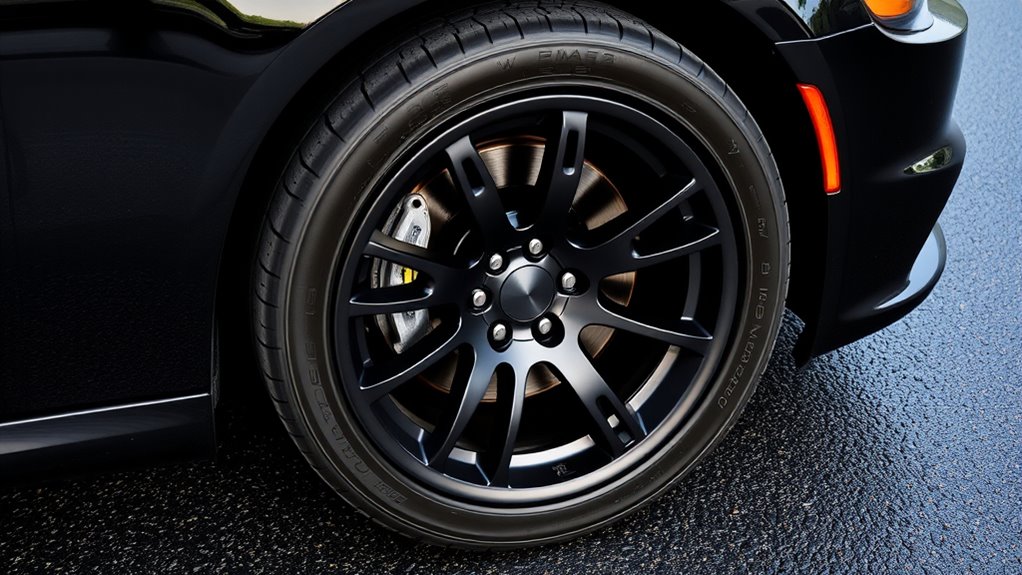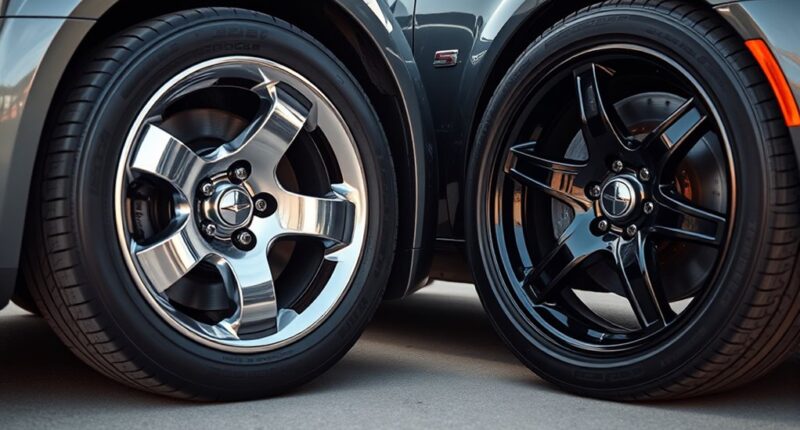For Dodge Magnum and Charger, you can choose from various bolt pattern sizes, mainly 5×115, with wheel sizes ranging from 17 to 22 inches and tires from 225/60/18 to 255/45/20. Compatibility hinges on correct offset, width, and overall diameter. Larger wheels may need suspension tweaks or brake adjustments to fit properly. To guarantee you get the perfect fit and safety, there’s more valuable info just ahead.
Key Takeaways
- Both Dodge Magnum and Charger share a 5×115 bolt pattern, allowing interchangeable OEM and aftermarket wheel options.
- Wheel sizes vary from 17×7.5 to 22 inches, with tire sizes adjusted to maintain overall diameter around 28.6–29.3 inches.
- Upgrading to larger wheels may require suspension modifications, wheel well adjustments, and brake system compatibility checks.
- Maintaining proper offset (+12mm to +20mm) and width ensures correct fitment and prevents rubbing or clearance issues.
- Choose reputable brands and verify fitment with tools or guides to ensure safe, performance-optimized wheel and tire combinations.
Understanding Stock Wheel and Tire Sizes for Magnum and Charger

Have you ever wondered what size wheels and tires come stock on your Dodge Magnum or Charger? The stock wheel sizes vary depending on the trim and year, with options like 17×7.5 inches or 20×8.5 inches. Corresponding tire sizes range from 225/60/18 to 255/45/20, ensuring proper fitment. Both vehicles share a 5×115 bolt pattern, making stock wheels interchangeable without modifications. The stock offsets typically sit between +12mm and +20mm, influencing how the wheels sit relative to the fenders. Knowing the stock wheel sizes and tire sizes helps you understand your vehicle’s baseline setup. Additionally, understanding vehicle specifications can assist in making informed upgrades or replacements, ensuring you choose compatible wheels and tires that maintain your car’s performance and appearance. Being aware of the standard sizes helps you avoid fitment issues when customizing your vehicle. For example, understanding wheel offset can help prevent rubbing or clearance problems when installing aftermarket wheels. It’s also beneficial to be familiar with tire load ratings, which ensure your tires can handle the weight and stress specific to your vehicle’s performance needs. Moreover, researching tire pressure recommendations can optimize safety and efficiency during driving.
Factors to Consider When Choosing New Wheel Sizes

When selecting new wheels for your Dodge Magnum or Charger, you need to verify they match your vehicle’s bolt pattern and are compatible with your model. Pay attention to the offset and width to avoid clearance issues and ensure proper fitment. Additionally, make sure the overall diameter stays within the stock or desired size to keep your speedometer accurate and prevent rubbing. For those interested in enhancing vehicle performance, considering Kia Tuning options can also provide valuable upgrades for your vehicle. Understanding vehicle compatibility factors can further assist in making the right choice.
Compatibility With Vehicle Models
Choosing the right wheel size for your Dodge Magnum or Charger requires careful consideration of the vehicle’s existing specifications. Both models share the same bolt pattern of 5x115mm, so many wheels are interchangeable. However, it’s crucial to check the stock offset, which typically ranges from +12 to +20mm, to ensure proper fitment. Larger wheel sizes, like 20×9.5 inches, may require suspension modifications or spacers to prevent rubbing issues. Additionally, keep the overall diameter of the wheel and tire within 28.3 to 29.3 inches to maintain accurate speedometer readings and vehicle calibration. By considering these factors, you can select wheels that fit your Dodge,Magnum perfectly, ensuring safety, performance, and style.
Proper Offset and Width
Selecting the right wheel offset and width is crucial for guaranteeing your Dodge Magnum or Charger fits properly and performs ideally. The correct wheel offset typically ranges from +12mm to +20mm to prevent rubbing and clearance issues. Wider wheels, like 9.5 inches, often need lower offsets (around +12mm to +15mm) to maintain a proper stance. When choosing wheel width, match it with compatible tire sizes—such as 275/40/20 for 9.5-inch widths—to maximize performance. Target Electronics Return Policy Consider these factors: 1. Guarantee the wheel offset keeps the wheel centered and avoids interference. 2. Match wheel width with appropriate tire sizes for optimal fit and handling. 3. Adjust offset and width for larger wheels (22×10 or 24×9.5) to prevent rubbing and improve fitment. Ensuring proper mammography guidelines and understanding your vehicle’s specifications will help you select the best combination. Additionally, understanding how astrology influences attractiveness can give insight into personal styling choices that complement your new wheel setup. Properly selecting wheels also involves understanding tire compatibility, which ensures optimal performance and safety. Staying informed about AI advancements in automotive technology can provide future insights into smart wheel and tire integration for enhanced vehicle performance. Getting these right ensures your vehicle looks great and performs smoothly.
Maintaining Correct Diameter
Maintaining the correct overall tire diameter is essential to guarantee your Dodge Magnum or Charger functions properly. Your goal is to keep the tire diameter close to stock, around 28.6 to 29.3 inches, to ensure accurate speedometer and odometer readings. When choosing a new wheel size, consider adjustments to the tire aspect ratio to preserve this diameter; for example, switching from 225/60/18 to 245/45/20 can maintain the same overall size. Keep in mind that larger wheels often mean lower sidewall height, which can affect ride comfort and increase the risk of rim damage from potholes. Use online tools or calculators to verify that your wheel size and tire diameter stay within your vehicle’s clearance limits, preventing rubbing or clearance issues. Additionally, understanding the contrast ratio of your projector can significantly influence the perceived depth and clarity of your home cinema images. Always check the tire size compatibility to avoid mismatches that could lead to premature tire wear or handling problems. Being aware of potential cybersecurity vulnerabilities when purchasing online can further protect your vehicle accessories and personal information during the upgrade process.
Popular Wheel Styles and Finishes for Dodge Models

Dodge models like the Charger and Magnum are known for their bold wheel styles and eye-catching finishes that enhance their muscular look. You’ll find factory options such as OEM wheels like Alcoa, Boss 338, and MSRT styles, finished in satin, chrome, or black to suit your taste. Popular aftermarket finishes include anthracite, brass monkey, gloss black, and chrome, allowing you to personalize your ride. When it comes to wheel styles, 20-inch multi-spoke designs like Superbees, Hellcat reps, and Dime series are especially popular for their aggressive appearance. Many enthusiasts opt for replica wheels that mirror OEM styles, balancing aesthetics and durability. Finish options like polished lips, satin black, and matte coatings help you customize your vehicle’s look to match your style. Cookie usage helps personalize your browsing experience, ensuring that the style choices you make align with your preferences. Incorporating farmhouse-inspired elements, such as natural textures and vintage accents, can add a unique touch to your vehicle’s customization. Additionally, selecting wheel sizes that complement your vehicle’s stance can significantly impact its overall aesthetic.
Recommended Tire Sizes for Different Wheel Diameters

Choosing the right tire size is key to guaranteeing your vehicle looks great and performs well with your upgraded wheels. For 20-inch wheels on your Dodge Magnum or Charger, recommended tire sizes include 255/45/20 and 245/45/20, providing an ideal fit. Upgrading to 22-inch wheels typically requires 265/30ZR22 or 275/30ZR22 tires, depending on width and clearance. For larger wheel diameters like 24 inches, lower profile tires such as 275/25/24 help maintain the proper overall diameter and speedometer accuracy. To avoid rubbing or fitment issues, tire diameters should stay within about 28.3 to 29.3 inches for 20-22 inch wheels. Always verify tire sizes align with your vehicle’s bolt pattern, offset, and suspension to ensure a perfect fit. Incorporating design thinking can also aid in selecting optimal combinations that balance aesthetics and performance. Considering dog breeds with specific size and profile characteristics can further assist in choosing tires that complement your vehicle’s look and handling. Additionally, understanding the compatibility of tire sizes with your specific model and modifications can prevent potential issues and improve overall driving experience. Being aware of tire longevity and storage conditions can help maintain tire quality over time, especially when upgrading or storing wheels for extended periods. Being mindful of manufacturing tolerances can also help ensure your tire choices fit within the expected performance and safety standards.
Compatibility Between Charger Rims and Magnum Models

Since both Charger and Magnum models share similar platform and bolt pattern specifications, their rims are generally interchangeable. This means you can often swap wheel and tire setups between the two without issues. To verify compatibility, keep these points in mind:
- Confirm the bolt pattern is 5x115mm for both vehicles.
- Match wheel size, offset, and width within acceptable ranges.
- Check that aftermarket or OEM Charger rims fit Magnum models properly.
- Remember that fatherhood impacts how you approach vehicle customization, emphasizing care and attention to detail.
Most Charger wheels, whether OEM or aftermarket, can be used on Magnum models, simplifying your wheel and tire upgrades. Proper compatibility depends on matching these specifications, allowing you to enjoy a wider selection of rims without modification. This interchangeability makes customizing your vehicle easier and more cost-effective.
Modifications Needed for Larger Wheels and Tires

When installing larger wheels and tires on your Dodge Magnum or Charger, you’ll likely need suspension adjustments like lift kits or lowering springs to make certain rubbing does not occur. You might also have to modify the wheel wells with spacers or change the wheel offset to ensure proper fitment. Don’t forget to check brake system compatibility to maintain safe and reliable performance. Additionally, considering wheel and tire combinations that are compatible with your vehicle’s specifications can help optimize both style and functionality.
Suspension Adjustments Required
Upgrading to larger wheels and tires on your Dodge Magnum or Charger often requires suspension modifications to guarantee proper clearance and performance. Without these adjustments, you risk rubbing, misalignment, and compromised handling. To ensure your setup works efficiently, consider these suspension tweaks:
- Lowering springs or lift kits to adjust ride height and prevent tire contact.
- Upgrading struts and shocks to maintain proper alignment and handling with bigger wheels.
- Reinforcing or upgrading suspension components like control arms, bushings, or sway bars to handle increased stress and keep everything aligned.
These modifications help you avoid clearance issues, maintain accurate speedometer readings, and ensure your suspension performs safely and smoothly with larger wheels and tires.
Wheel Well Modifications
To fit larger wheels and tires on your Dodge Magnum or Charger, you’ll often need to modify the wheel wells to prevent rubbing and guarantee proper clearance. Upgrading to bigger wheels, like 24-inch or more, can cause stress on the wheel well and may require fender flares or rolling to accommodate the increased tire width. You might also need to trim or adjust inner fender liners, or add spacers, to prevent contact during suspension travel. These modifications help maintain a smooth ride and avoid damage. Proper measurements and adjustments to the offset, as well as suspension tweaks, are vital for a perfect fit. Here’s a quick look at common wheel well modifications:
| Modification Type | Purpose |
|---|---|
| Fender Flares | Increase width for wider tires |
| Rolling | Prevent rubbing against liner |
| Trimming | Remove excess material |
| Spacers | Adjust wheel positioning |
| Suspension tweaks | Improve clearance |
Brake System Compatibility
Expanding your wheel and tire size on a Dodge Magnum or Charger often means more than just swapping rims; it requires careful adjustments to the brake system. Larger wheels can interfere with brake components, so you must guarantee proper wheel clearance to prevent rubbing or safety issues. To maintain ideal braking performance, consider these modifications:
- Upgrading to aftermarket brake kits, like Wilwood or TCE, which often need spacers or custom brackets for larger rotors and calipers.
- Checking wheel clearance thoroughly to avoid interference between brake components and wheel spokes.
- Adjusting wheel offset or adding spacers if necessary, to accommodate bigger brake systems while maintaining safe clearance.
Failure to address these factors can compromise braking safety and performance during stops. Proper assessment ensures your brake system remains compatible with larger wheels.
Measuring and Verifying Proper Fitment

Before installing new wheels and tires on your Dodge Magnum or Charger, it’s essential to measure and verify proper fitment to avoid rubbing or clearance issues. Start with fitment verification by using an online fitment tool like BigCustomWheels to check that your selected wheel and tire sizes will fit without interference. Take vehicle measurements, including your current wheel offset, backspacing, and overall diameter, and compare them to the new specifications. Confirm that the bolt pattern (e.g., 5×115) matches your vehicle’s requirements. Additionally, check the tire’s overall diameter and width against your wheel’s width and fender clearance to prevent rubbing during turns or suspension movement. Proper vehicle measurements ensure your new setup maintains safety, performance, and aesthetics.
Impact of Wheel Offset and Width on Performance and Clearance

Wheel offset and width directly influence how your Dodge Magnum or Charger handles and fits. Proper offset guarantees your wheels sit correctly relative to the suspension and fenders, preventing rubbing or clearance issues. Increasing wheel width can improve grip but often requires adjusting the offset; otherwise, it risks interference with brakes or inner fenders. A wider wheel with a more negative offset pushes the tire outward for an aggressive stance, but may cause clearance problems. Conversely, a higher positive offset pulls the wheel inward, improving fitment. To optimize performance and clearance, consider these key points:
- Ensure wheel width matches the appropriate offset for your tire size.
- Adjust offset to avoid rubbing against suspension components or fenders.
- Balance width and offset to enhance handling without compromising clearance.
Tips for Upgrading Wheels and Tires Safely and Effectively

Upgrading your wheels and tires can considerably enhance your Dodge Magnum or Charger’s performance and appearance, but it’s essential to do so safely and correctly. First, verify wheel fitment by checking the bolt pattern, size, and offset to prevent clearance issues. Use tire size calculators and fitment guides to ensure your new tires match the vehicle’s diameter, avoiding calibration problems. If you’re installing larger wheels, like 22” or 24”, consider suspension modifications such as lowering springs or lifts to prevent rubbing and ensure proper clearance. Prioritize quality materials from reputable brands to boost safety, durability, and performance. For extra confidence, consult with professionals or browse forum discussions to confirm your choices, especially when combining aftermarket rims, larger sizes, or performance upgrades.
Frequently Asked Questions
Is the Dodge Magnum the Same as the Dodge Charger?
No, the Dodge Magnum isn’t the same as the Dodge Charger. You’ll notice the Magnum is a wagon with a station wagon shape, while the Charger is a sleek, four-door sedan. Although they share the same platform and some parts, their designs and styles differ markedly. You’ll find the Magnum offers more cargo space, but the Charger emphasizes sporty performance and a more traditional sedan look.
What’s the Lug Pattern for a Dodge Charger?
The Dodge Charger typically has a 5-lug pattern with a bolt circle diameter of 115mm, which is common for most models. You’ll want to verify this pattern before purchasing new wheels or tires to guarantee proper fitment. Keep in mind, some Chargers may have a different pattern like 5x127mm, but most standard models use the 5x115mm bolt pattern. Always double-check your specific vehicle’s specs.
What Size Tires Can You Put on a Dodge Charger?
You can fit a range of tire sizes on your Dodge Charger, depending on your wheel setup. Stock sizes typically include 245/45/20 and 275/40/20, but you can go larger with 22-inch wheels and tires like 265/30/22 or 295/30/22. Just make sure to match tire width and aspect ratio to your wheel size to avoid rubbing and maintain proper handling. Always check clearance before upgrading.
What Rims Fit a Charger?
When choosing rims for your Charger, you need to think about bolt pattern, size, and offset. You’ll find that 20×9.5-inch wheels with around +15mm offset fit well, especially if you upgrade or customize. OEM options like SRT8 or aftermarket styles like Boss 338 and Hellcat are compatible. Make sure to verify fitment details to avoid rubbing or clearance issues, especially when going larger or modifying suspension.
Conclusion
Upgrading your Dodge Magnum or Charger can transform your ride, but it’s essential to choose the right wheel and tire combo. For example, imagine fitting larger wheels to improve handling—if you don’t verify clearance, you might encounter rubbing issues. By understanding stock sizes, considering offsets, and measuring carefully, you guarantee a safe, stylish upgrade. Take your time, do your research, and enjoy the enhanced performance and look without risking damage or safety.










